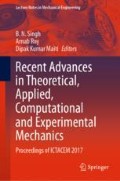Abstract
While designing the wind tunnel components, extreme care is taken for the designing of the contraction wall profile. Contraction plays an important role in flow uniformity and turbulence reduction inside the test section. Due to this, researchers are having a greater interest in the designing of a contraction wall profile. The sixth-order polynomial curve proposed by Sargison et al. is a well-acknowledged design for the contraction wall profile. Almost all design criteria were considered for the designing of the sixth-order polynomial curve except the proportionality criteria of inlet and outlet radii. According to the design criteria, the inlet radius must be larger compared to the outer radius of the contraction but in the sixth-order polynomial design, both the radii are almost similar. A transformed polynomial design was proposed by Daniel Brassard to meet this design criterion by changing the value of polynomial according to a proposed variable α. In this paper, the open-source CFD tool OpenFOAM was used to analyse the transformed sixth-order polynomial. The adverse pressure gradient, uniformity of flow, and turbulence intensity inside the test section as well as at the contraction outlet was taken into account for the analysis. The comparative results from the analysis show that the transformed polynomial model is giving better outcomes than the conventional sixth-order polynomial model.
Access this chapter
Tax calculation will be finalised at checkout
Purchases are for personal use only
References
Mehta RD, Bradshaw P (1979) Design rules for small low speed wind tunnels. Aeronaut J 83(827):443–453
Dolan DS, Zepeda D, Taufik T (2011) Development of wind tunnel for laboratory wind turbine testing. In: North American power symposium (NAPS), pp 1–5. IEEE
Panda MK, Samanta AK (2016) Design of low cost open circuit wind tunnel—a case study. Indian J Sci Technol 9(30)
Cattafesta L, Bahr C, Mathew J (2010) Fundamentals of wind‐tunnel design. Encycl Aerosp Eng
Rouse H, Hassan MM (1949) Cavitation-free inlets and contractions. Mech Eng 71(3):213–216
Bell JH, Mehta RD (1988) Contraction design for small low-speed wind tunnels
Mikhail MN (1979) Optimum design of wind tunnel contractions. AIAA J 17(5):471–477
Wolf T (1995) Design of a variable contraction for a full-scale automotive wind tunnel. J Wind Eng Ind Aerodyn 56(1):1–21
Lastra MR, Oro JMF, Vega MG, Marigorta EB, Morros CS (2013) Novel design and experimental validation of a contraction nozzle for aerodynamic measurements in a subsonic wind tunnel. J Wind Eng Ind Aerodyn 118:35–43
Hoghooghi H, Ahmadabadi MN, Manshadi MD (2016) Optimization of a subsonic wind tunnel nozzle with low contraction ratio via ball-spine inverse design method. J Mech Sci Technol 30(5):2059–2067
Abdelhamed AS, Yassen YES, ElSakka MM (2015) Design optimization of three dimensional geometry of wind tunnel contraction. Ain Shams Eng J 6(1):281–288
Sargison JE, Walker GJ, Rossi R (2004) Design and calibration of a wind tunnel with a two dimensional contraction. In: Australasian fluid mechanics conference, The University of Sydney, Australia
Brassard D, Ferchichi M (2005) Transformation of a polynomial for a contraction wall profile. Trans ASME I J Fluids Eng 127(1):183–185
Lakshman R, Basak R (2018) Analysis of transformed fifth order polynomial curve for the contraction of wind tunnel by using OpenFOAM. In: IOP conference series: materials science and engineering, vol 377, no 1, p 012048. IOP Publishing
OpenFOAM (2015) The open source CFD toolbox, User guide, Version 3.0.1
Anderson JD, Wendt J (1995) Computational fluid dynamics, vol 206. McGraw-Hill, New York
Author information
Authors and Affiliations
Corresponding author
Editor information
Editors and Affiliations
Rights and permissions
Copyright information
© 2020 Springer Nature Singapore Pte Ltd.
About this paper
Cite this paper
Lakshman, R., Basak, R. (2020). Analysis of Transformed Sixth-Order Polynomial for the Contraction Wall Profile by Using OpenFOAM. In: Singh, B., Roy, A., Maiti, D. (eds) Recent Advances in Theoretical, Applied, Computational and Experimental Mechanics. Lecture Notes in Mechanical Engineering. Springer, Singapore. https://doi.org/10.1007/978-981-15-1189-9_11
Download citation
DOI: https://doi.org/10.1007/978-981-15-1189-9_11
Published:
Publisher Name: Springer, Singapore
Print ISBN: 978-981-15-1188-2
Online ISBN: 978-981-15-1189-9
eBook Packages: EngineeringEngineering (R0)

